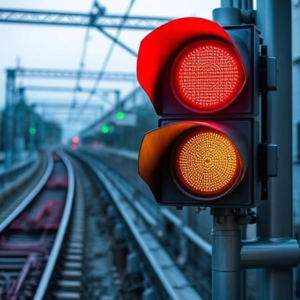Electronic Signaling and Track Circuit Systems are key technologies used in railways to ensure that trains run safely and efficiently. These systems help control the movement of trains, making sure they don’t collide and that they follow the right path. Let’s break it down into simpler parts:
1. What is Electronic Signaling?
Electronic signaling is a system that uses electronic signals (like lights or digital displays) to communicate with train drivers. It’s like how traffic lights control the movement of cars on roads.
- Signals are placed at different points along the railway tracks.
- These signals tell the train driver when to stop, go, or slow down, based on the train’s current position, the condition of the track, and other trains that might be ahead.

2. How Do Electronic Signals Work?
- Red Light: This means stop. It could be because the track ahead is occupied by another train or there’s an issue with the signal.
- Green Light: This means it’s safe to go. The train driver can continue, as the track is clear.
- Yellow Light (or Amber): This means caution. It warns the driver to slow down and be ready to stop if needed.
3. What Are Track Circuit Systems?
Track circuits are another important technology used in railways to help manage train movements. Track circuits work by using electricity to monitor the tracks. Here’s how it works:
- How Track Circuits Work:
- The railway track is divided into sections (called blocks), each of which is controlled by a track circuit.
- Electricity flows through the track in each section.
- When a train moves into a section, its metal wheels and axles complete the electrical circuit. This tells the signaling system that the track section is occupied by a train.
- When the Track is Empty:
- If no train is present, the electricity flows freely through the track section, and the signaling system knows the track is clear.
- When a Train is Present:
- When a train moves into a section, its wheels connect the electrical circuit. This tells the system that the section is occupied, and the signal will turn red, warning the driver to stop or wait.
4. Why Are These Systems Important?
These systems make sure trains don’t collide with each other and that they follow the right track at the right time. Here’s how:
- Prevent Collisions: If a train is already in a section, the track circuit ensures no other train enters that section. The signaling system will show a red light to any train approaching that section, telling the driver to stop.
- Efficient Train Movement: The system allows trains to be spaced out properly, ensuring that they can run safely without having to wait unnecessarily.
- Safety: If there’s an issue with the track, such as damage or a problem with the signal, the system can immediately alert train operators, preventing accidents.
5. Advantages of Electronic Signaling and Track Circuits
- Real-Time Monitoring: These systems provide real-time data, so operators always know where trains are and whether tracks are clear.
- Improved Train Scheduling: By automatically controlling train movements, these systems allow more efficient use of tracks, meaning more trains can run without risk of delays or collisions.
- Reduced Human Error: The system reduces the risk of mistakes from train operators or signal operators by automating much of the process of monitoring the tracks and controlling train movements.
- Enhanced Safety: The technology helps detect problems, such as a train stopping in an unexpected location or signals not working properly, and allows operators to respond quickly.
6. How Are They Used Together?
Electronic signaling and track circuits work together to create a safer, more efficient train network:
- Track Circuits: Tell the system whether a train is in a section of track.
- Electronic Signals: Use this information to set the correct signal (red, yellow, green) to guide the train driver.
Example of How They Work Together:
- If a train is moving along the track and enters a new section, the track circuit detects this and tells the signaling system that the section is now occupied.
- The signaling system then displays a red signal for any trains approaching that section, preventing them from entering the occupied block.
- Once the train moves out of the section, the track circuit detects that the section is clear and the signal turns green, allowing other trains to move safely.
7. Modern Upgrades and Automation
In modern systems, digital signaling and communication-based train control (CBTC) have been introduced. These technologies allow for more precise control, faster response times, and better coordination between trains, even in busy networks.
Conclusion
Electronic Signaling and Track Circuit Systems work together to keep trains moving safely and efficiently. Track circuits detect when a train is in a section of track by using electricity, while electronic signals communicate to train drivers whether they should stop, slow down, or proceed. These technologies help prevent accidents, improve train schedules, and make the whole railway system safer and more reliable.
Keywords: Electronic Signaling, Railway











